Cross-leaved Heath
Cross-leaved Heath is a type of heather that gets its name from the distinctive whorls of four leaves that occur along its stems. An evergreen shrub, it prefers acid bogs and wet heath or moorland. It flowers between July and September and attracts many nectar-loving insects including bees and moths.
Purple-carpeted heaths are an iconic feature of the UK's landscape and are the result of hundreds of years of low-impact human activities such as livestock-grazing and scrub clearance. Yet development and the decline of traditional farming methods have caused many of these precious habitats to be lost - over 80% of lowland heathland in the UK has disappeared in just 200 years. The Wildlife Trusts manage many heathland habitats for the benefit of wildlife; by volunteering for your local Trust you can help too, and you'll make new friends and learn new skills along the way.
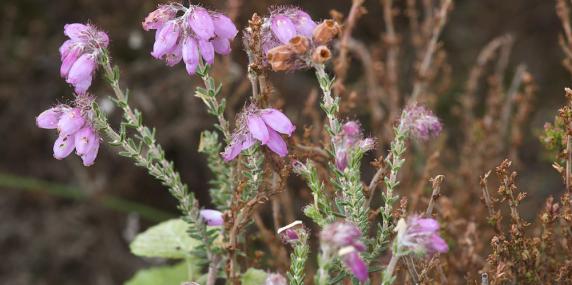
Deptford Pink
The Deptford Pink has declined rapidly in range and is now known to inhabit only about 15 sites in the UK, mainly in the south. It prefers light, sandy, acidic soils and requires open conditions to grow well. It can be found on disturbed ground, such as tracks and field edges, along hedgerows and in dry pasture.
The Deptford Pink has suffered serious declines over recent years mainly due to the intensification of agriculture and removal of hedgerows. The Wildlife Trusts are working closely with farmers and landowners to promote wildlife-friendly practices to help this and many other species. We are working towards a 'Living Landscape': a network of habitats and wildlife corridors across town and country, which are good for both wildlife and people. You can support this greener vision for the future by joining your local Wildlife Trust.
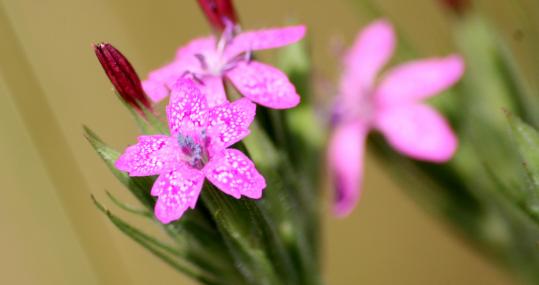
Marsh Cinquefoil
Marsh Cinquefoil likes wet, boggy places, fens and peaty meadows. When it is in flower, between May and July, it is a good source of food for nectar-loving insects such as bees and hoverflies. Marsh Cinquefoil is one of a number of cinquefoils, but is unique in the UK as the only one with deep red flowers - the rest have yellow flowers. It is a member of the rose family.
Human activity, including the drainage of land for agriculture, the loss of ponds through development and the removal of wet woods, has resulted in the disappearance of many of the UK's wetlands. The Wildlife Trusts are working closely with planners, developers and farmers to ensure our wetlands are protected. You can help by becoming a member of your local Trust; you'll find out about exciting wildlife happenings, events on your doorstep and volunteering opportunities, and be helping local wildlife along the way.

Pheasant's-eye
Before the Second World War, arable weeds, such as Pheasant's-eye, would have peppered the landscape with colour in the summer months. But the post-war intensification of agriculture and widespread use of herbicides have driven these species to the brink of extinction in the wild. Nevertheless, The Wildlife Trusts manage many farmland and grassland habitats for the benefit of these plants, often using traditional methods. By volunteering for your local Trust you can help too, and you'll make new friends and learn new skills along the way.
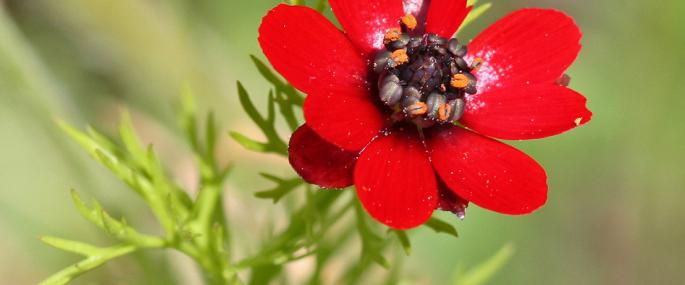
Cornflower
Once considered as a weed of arable fields, the development of intensive agricultural practices all but wiped out Cornflowers in the wild. This delicate, blue flower is now most likely to occur as a garden escapee, as part of intentional wildflower seeding, or as the result of the disturbance of soil containing old seed banks. Its strongholds remain roadside verges, scrub and wasteland. It flowers from June to August, often alongside other 'arable weeds' (also called 'cornfield flowers') such as Corn Chamomile and Corncockle.
Before the Second World War, arable weeds, such as Cornflower, would have peppered the landscape with colour in the summer months. But the post-war intensification of agriculture and widespread use of herbicides have driven these species to the brink of extinction in the wild. Nevertheless, The Wildlife Trusts manage many farmland and grassland habitats for the benefit of these plants, often using traditional methods. By volunteering for your local Trust you can help too, and you'll make new friends and learn new skills along the way.
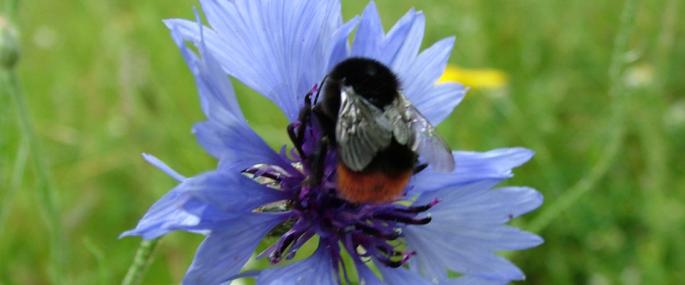
Dog-violet
If you see a violet in the wild, it is most likely to be the Common Dog-violet; this common and widespread plant lives happily in many different habitats including woodland, grassland, heaths, hedgerows and old pasture. It flowers from April to June but its flowers are not scented, unlike those of its cousin, the Sweet Violet. The latter was used in Ancient Greece as a perfume and Medieval Britain as a deodorant.
The Wildlife Trusts manage many nature reserves for the benefit of all kinds of wildlife, including many different species of plants. But these precious sites are under threat from development, intensive agricultural practices and climate change. You can help by supporting your local Trust and becoming a member; you'll find out about exciting wildlife happenings, events on your doorstep and volunteering opportunities, and be helping local wildlife along the way.
Marsh Violet
The Marsh Violet is a relative of the well-known pansy and likes damp and acidic places such as wet woodlands, bogs and marshes. For gardeners, it makes a good addition to the edge of a pond or a bog garden.
Human activity, including the drainage of land for agriculture, the loss of ponds through development and the removal of wet woods, has resulted in the disappearance of many of the UK's wetlands. The Wildlife Trusts are working closely with planners, developers and farmers to ensure our wetlands are protected. You can help by becoming a member of your local Trust; you'll find out about exciting wildlife happenings, events on your doorstep and volunteering opportunities, and be helping local wildlife along the way.
Perforate St John's-wort
Perforate St John's-wort can be found in open woods, along hedgerows and roadside verges and on waste ground. Its bright yellow flowers appear from June to September and the blood-red juice that exudes from its stems has made it a focus for much myth and ritual. For instance, torchlight processions and gorse-burning were just some of the activities undertaken on Midsummer's Day, a pagan festival soon replaced by the Feast of St John the Baptist, hence the common name of this plant. It's also said that the red juice from its stem represents his bloody murder.
The Wildlife Trusts manage many nature reserves for the benefit of all kinds of wildlife, including many different species of plants. But these precious sites are under threat from development, intensive agricultural practices and climate change. You can help by supporting your local Trust and becoming a member; you'll find out about exciting wildlife happenings, events on your doorstep and volunteering opportunities, and be helping local wildlife along the way.
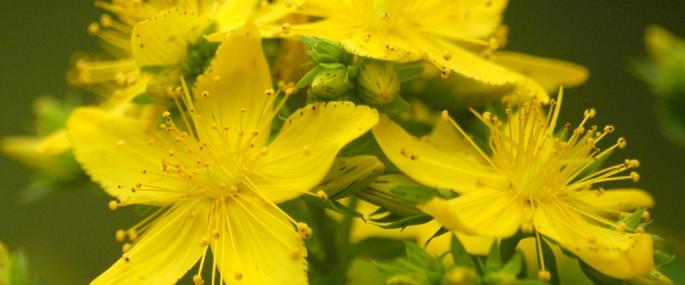
Toadflax-leaved St John's-wort
Toadflax-leaved St John's-wort is a fussy plant that has very particular habitat requirements, explaining its rarity and limited range. It needs plenty of space with few other competitive plants nearby, and acidic soils in warm areas. Steep rocky slopes exposed to the sun are a favourite. It is a perennial species and flowers between June and July.
Toadflax-leaved St John's-wort is a rare and declining plant due to the loss of open habitats under scrub, particularly Gorse. The Wildlife Trusts manage many heathland and grassland habitats for the benefit of wildlife - careful grazing with traditional breeds and scrub clearance are just a couple of the ways they ensure a balance of plants and cover in these fragile habitats. By volunteering for your local Trust you can help too, and you'll make new friends and learn new skills along the way.
Opposite-leaved Golden-Saxifrage
Opposite-leaved Golden Saxifrage is a moisture-loving plant that is found in any habitat near damp or wet places, such as by the side of shady streams and in wet woodlands. It is a creeping perennial that forms mats of golden-green flowers between April and June. The flowers form 'trickles of gold' wherever there is seeping water on a bank or streamside.
Human activity, including the drainage of land for agriculture, the loss of ponds through development and the removal of wet woods, has resulted in the disappearance of many of the UK's wetlands. The Wildlife Trusts are working closely with planners, developers and farmers to ensure our wetlands are protected. You can help by becoming a member of your local Trust; you'll find out about exciting wildlife happenings, events on your doorstep and volunteering opportunities, and be helping local wildlife along the way.